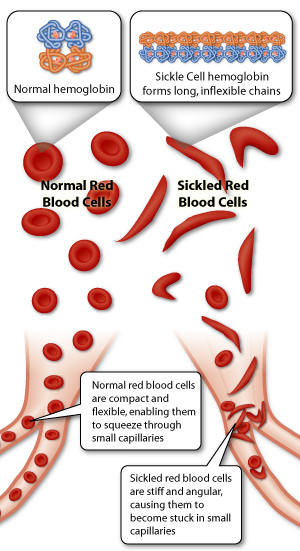What is Sickle-Cell Anemia? Sickle-Cell disease is an inherited disease of red blood cells. People with sickle cell disease have abnormal hemoglobin, the protein inside red blood cells that carries oxygen to every part of the body. The abnormal hemoglobin causes the red blood cells to become C-shaped (like a farm tool called a sickle) and stiff. The sickled red blood cells tend to stick together and get caught in blood vessels, sometimes blocking them. What are the causes of Sickle-Cell Anemia? Sickle-Cell is an inherited disease; two genes are inherited, one from each parent. If a person only inherits one sickle cell gene, however, they will only have the sickle cell gene; which can be passed down to their children. Who has the chances of being a victim of Sickle-Cell Anemia? Sickle-Cell Anemia is most common in people whose families come from Africa, South or Central America , Caribbean islands, Mediterranean countries, India, and Saudi Arabia. In the United States, it’s estimated that sickle cell anemia affects 70,000–100,000 people, mainly African Americans. The disease occurs in about 1 out of every 500 African American births. Sickle cell anemia also affects Hispanic Americans. The disease occurs in 1 out of every 36,000 Hispanic American births. About 2 million Americans have sickle cell trait. The condition occurs in about 1 in 12 African Americans. What are the symptoms of Sickle-Cell Anemia? The symptoms and signs of Sickle-Cell Anemia may vary depending on the severeness. Sickle-Cell Anemia is present at birth, but most infants do not show any signs or symptoms until about 4 months of age. Most signs of Anemia are:
|
 How is Sickle-Cell Anemia diagnosed? An early diagnosis of Sickle-Cell is important to the treatment of the victim. In most cases, tests for Sickle-Cell are done prenatally; the results of the tests then sent to your primary doctor. The procedure of testing prenatally consists of testing a sample of either a sample of amniotic fluid or tissue taken from the placenta, testing for the Sickle-Cell gene. The procedure of testing after birth consists of a blood test. If then the blood of the infant tests positive for sickle hemoglobin, a second blood test is ordered as soon as possible to confirm the diagnosis. What are the ways to treat or cure Sickle-Cell Anemia? There is no exact cure for Sickle-Cell Anemia, but treatments for symptoms are currently available. Bone marrow transplants or stem cell transplants sometimes are possible treatments to a small number of Sickle-Cell cases. Researchers are in the process studying a number of ways to treat patients with Sickle-Cell. |
|